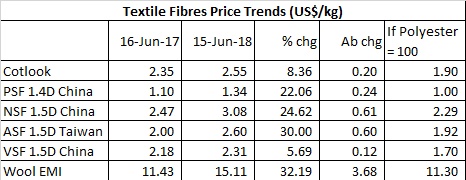Cotton prices were slower to rise in one year, polyester still cheapest
Cotton prices were slower to rise in the last one year until mid-June among the major fibres used in textile production globally. Prices measured in terms of Cotlook A Index, which represent spot markets, rose just above 8% between mid-June 2017 and mid-June 2018. In similar comparison, polyester fibre (PSF) was dearer by 22%, nylon staple (NSF) by 25%, acrylic staple (ASF) by 30%. Viscose staple (VSF) was the slowest to rise at less than 6%.
[The analysis is based on various “Global Markets Weekly Review” published by Textilebeacon.com]
This does not anyway imply that cotton is cheaper for textile production. Cotlook A was at US cents 101.45 per pound or US$2.55 per kg as of 15 June. PSF remains the cheapest fibre at US$1.34 per kg in China. Thus, cotton is almost 1.9 times costlier than PSF, although their applications complement each other. While polyester pricing is primarily determined, among others, by crude oil prices, cotton prices are ruled by climatic conditions – a natural phenomenon.
Other fibres used largely in textile making include ASF, NSF, VSF and wool. However, many of these have special applications apart from textile and prices are determined accordingly. Among manmade fibres, ASF is used to substitute wool, which is the costliest fibre in textile making. Viscose substitutes silk which is also costlier. NSF has other application in industrial and engineering and is termed technically superior among all. Assuming the basic fibre as polyester – than VSF is 1.7 times, ASF 1.9 times, NSF 2.3 times and wool more than 11 times the price of PSF.

Thus, blending is done of costlier fibre either with cotton or polyester or all. Textile makers, particularly yarn and fabric suppliers, in order to keep prices affordable blend various fibre in different permutation-combination but retain final look and feel of textile product in line with the end-consumers’ taste and preference.
Cotton alone accounts for one-third of global fibre use and has been the first among fibres to be used in textiles. It is grown in very few countries in the world with India being the largest producer. Cotton crop depends on South-west monsoon in India and are also plagued with pest infestation. This factors also holds for cotton crop in Pakistan too. The recent unfavourable climatic condition in Texas, US and China’s endeavor to import additional cotton has pushed cotton prices up, but the former had also pushed prices up last year. Thus, the slower rise in cotton price we see in the last 52 weeks. On the other hand, rising crude oil prices are supporting manmade fibre like polyester, nylon and acrylic prices in recent weeks. Viscose is independent of such adverse factors, but environment damage controls initiatives have seen driving the viscose market occasionally, hence it prices have moved the slowest.